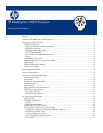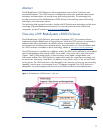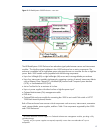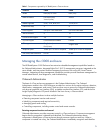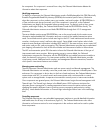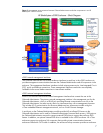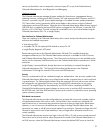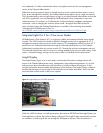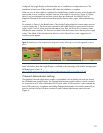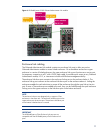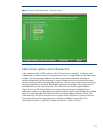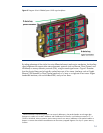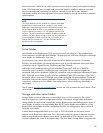the component. If a component is removed from a bay, the Onboard Administrator deletes the
information about that component.
Identifying components
To identify a component, the Onboard Administrator reads a Field-Replaceable Unit (FRU) Electrically
Erasable Programmable Read-Only Memory (EEPROM) that contains specific factory information
about the component, such as product name, part number, and serial number. All FRU EEPROMs in
c-Class enclosures are always powered, even if the component is turned off, so the Onboard
Administrator can identify the component before granting power. For devices such as fans, power
supplies, and Insight Display, the Onboard Administrator reads the FRU EEPROMs directly. The
Onboard Administrator accesses server blade FRU EEPROMs through their iLO 2 management
processors.
The server blades contain several FRU EEPROMs: one on the server board which contains server
information and embedded NIC information and one on each of the installed mezzanine option
cards. Server blade control options include auto login to the iLO 2 web interface and remote server
consoles, virtual power control, and boot order control. Server blade control options also include
extensive server hardware information including BIOS and iLO 2 firmware versions, server name, NIC
and option card port IDs, and port mapping. The Onboard Administrator provides easy-to-understand
port mapping information for each of the server blades and interconnect modules in the enclosure.
The NIC and mezzanine option FRU information informs the Onboard Administrator of the type of
interconnects each server requires. Before granting power to a server blade, the Onboard
Administrator compares this information with the FRU EEPROMs on installed interconnect modules to
check for electronic keying errors. For interconnect modules, the Onboard Administrator provides
virtual power control, dedicated serial consoles, and management Ethernet connections, based on
which specific interconnect features are included.
Managing power and cooling
The most important Onboard Administrator tasks are power control and thermal management. The
Onboard Administrator can remotely control the power state of all components in BladeSystem c-Class
enclosures. For components in device bays in the front of each enclosure, the Onboard Administrator
communicates with iLO 2 to control servers and communicates with a microcontroller to control
options such as storage blades. A separate microcontroller controls power to interconnect modules.
Once components are granted power, the Onboard Administrator begins thermal management with
Thermal Logic. The Thermal Logic feature in the BladeSystem c3000 enclosure minimizes fan
subsystem power consumption by reading temperature sensors across the entire enclosure and
changing fan speed in different zones to minimize power consumption and maximize cooling
efficiency. More detailed information on Thermal Logic technologies follows later in this technology
brief.
Controlling components
The Onboard Administrator uses embedded management interfaces to provide detailed information
and health status for all bays in the enclosure (Figure 3). The Onboard Administrator also offers
information on firmware versions for most components in the enclosure and can be used to update
those components.
6



